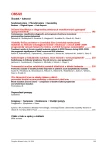Proteomic analysis of soluble proteins important in pediatric acute lymphoblastic leukemia
Authors:
M. Kováč 1,2; D. Petráčková 3; S. Bezoušková 3; V. Pelková 1,2; M. Vášková 1,2; E. Mejstříková 1,2; T. Kalina 1,2; J. Weiser 3; J. Starý 3; O. Hrušák 1,2
Authors‘ workplace:
CLIP – Childhood Leukemia Investigation Prague, 2Klinika dětské hematologie a onkologie, UK 2. LF a FN v Motole, Praha, 3Mikrobiologický ústav AV ČR, Praha
1
Published in:
Transfuze Hematol. dnes,16, 2010, No. 4, p. 218-222.
Category:
Comprehensive Reports, Original Papers, Case Reports
Overview
In acute leukemia (AL), several clinical symptoms may be caused by soluble factors secreted by AL cells into the bone marrow (BM) microenvironment. On the other hand, AL cells are often dependent on the microenvironment of the host, with most AL cells dying during first days after transferred to in vitro. This support of leukemic cells may be mediated by soluble factors as well. Attention is logically focused on malignant cells and the composition of soluble factors may be unjustly omitted. We aimed at identifying proteins in BM plasma of children with lymphoblastic AL (ALL), which may be responsible for ALL aggressiveness or for microenvironment-mediated survival of ALL cells. BM plasma and blood samples were analyzed by protein microarray and/or by two-dimensional electrophoresis (2D PAGE). We detected 23 proteins with a significantly different concentration in patients by Protein microarray. Before 2D PAGE, BM plasma was immuno-depleted from 12 abundant proteins by affinity chromatography. With this approach we succeeded to increase the number of spots that were analyzed by the PDQuest software.
Key words:
acute lymphoblastic leukemia, protein array, two-dimensional electrophoresis, protein
Sources
1. Pui CH, Robison LL, Look AT. Acute lymphoblastic leukaemia. Lancet 2008; 371 : 1030-1043.
2. Schultz KR, Pullen DJ, Sather HN, et al. Risk - and response-based classification of childhood B-precursor acute lymphoblastic leukemia: a combined analysis of prognostic markers from the Pediatric Oncology Group (POG) and Children’s Cancer Group (CCG). Blood 2007; 109 : 926-935.
3. Zelent A, Greaves M, Enver T. Role of the TEL-AML1 fusion gene in the molecular pathogenesis of childhood acute lymphoblastic leukaemia. Oncogene 2004; 23 : 4275-4283.
4. Ito C, Kumagai M, Manabe A, et al. Hyperdiploid acute lymphoblastic leukemia with 51 to 65 chromosomes: a distinct biological entity with a marked propensity to undergo apoptosis. Blood 1999; 93 : 315-320.
5. Nishii K, Katayama N, Miwa H, et al. Survival of human leukaemic B-cell precursors is supported by stromal cells and cytokines: association with the expression of bcl-2 protein. Br J Haematol 1999; 105 : 701-710.
6. Nishigaki H, Ito C, Manabe A, et al. Prevalence and growth characteristics of malignant stem cells in B-lineage acute lymphoblastic leukemia. Blood 1997; 89 : 3735-3744.
7. Iversen PO, Wiig H. Tumor necrosis factor alpha and adiponectin in bone marrow interstitial fluid from patients with acute myeloid leukemia inhibit normal hematopoiesis. Clin Cancer Res 2005; 11 : 6793-6799.
8. Ross ME, Zhou X, Song G, et al. Classification of pediatric acute lymphoblastic leukemia by gene expression profiling. Blood 2003; 102 : 2951-2959.
9. van Zelm MC, van der Burg M, de Ridder D, et al. Ig gene rearrangement steps are initiated in early human precursor B cell subsets and correlate with specific transcription factor expression. J Immunol 2005; 175 : 5912-5922.
10. Su AI, Wiltshire T, Batalov S, et al. A gene atlas of the mouse and human protein-encoding transcriptomes. Proc Natl Acad Sci U S A 2004; 101 : 6062-6067.
11. Metcalf D. The unsolved enigmas of leukemia inhibitory factor. Stem Cells 2003; 21 : 5-14.
12. Metcalf D. The leukemia inhibitory factor (LIF). Int J Cell Cloning 1991; 9 : 95-108.
13. Murate T, Hayakawa T. Multiple functions of tissue inhibitors of metalloproteinases (TIMPs): new aspects in hematopoiesis. Platelets 1999; 10 : 5-16.
14. Hayakawa T, Yamashita K, Ohuchi E, Shinagawa A. Cell growth-promoting activity of tissue inhibitor of metalloproteinases-2 (TIMP-2). J Cell Sci 1994; 107 ( Pt 9): 2373-2379.
15. Stetler-Stevenson WG, Bersch N, Golde DW. Tissue inhibitor of metalloproteinase-2 (TIMP-2) has erythroid-potentiating activity. FEBS Lett 1992; 296 : 231-234.
16. Lin LI, Lin DT, Chang CJ, Lee CY, Tang JL, Tien HF. Marrow matrix metalloproteinases (MMPs) and tissue inhibitors of MMP in acute leukaemia: potential role of MMP-9 as a surrogate marker to monitor leukaemic status in patients with acute myelogenous leukaemia. Br J Haematol 2002; 117 : 835-841.
17. Guedez L, Courtemanch L, Stetler-Stevenson M. Tissue inhibitor of metalloproteinase (TIMP)-1 induces differentiation and an antiapoptotic phenotype in germinal center B cells. Blood 1998; 92 : 1342-1349.
Labels
Haematology Internal medicine Clinical oncologyArticle was published in
Transfusion and Haematology Today

2010 Issue 4
Most read in this issue
- Contemporary classification diagnostic and prognosis of primary monoclonal gammopathies (paraproteinemias)
- Blood donation and iron stores – comparison of double erythrocytapheresis and whole blood donation
-
Radioterapie u folikulárního lymfomu.
Stará historie v nové perspektivě? - Treatment results of chronic myeloid leukemia patients in HOK Olomouc during 2000–2009: the prognostic significance of Sokalęs score and ELN criterions
